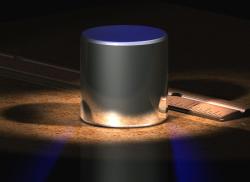Thank you! Your e-mail has been sent. Return to the original page.
A new definition of the kilogram
Published Mar 18, 2014Stored in a basement at the National Physical Laboratory (NPL) is the UK's National Standard Kilogram, a copy of the international prototype and the standard for all mass measurements in the UK. But researchers at the NPL, and elsewhere, are working hard to make the international prototype obsolete, and there's a very good reason why.
Of all the standard units currently in use around the world, the kilogram – the official unit of mass in the International System of Units (SI) – is the only one that still relies on a physical object for its definition.
The mass of the kilogram (kg) is defined by the international prototype of the kilogram, the IPK, and this is kept at the International Bureau of Weights and Measures (BIPM) in France. It is made of an alloy of platinum (90%) and iridium (10%).
The IPK has served as the standard to which all nations’ prototype kilograms have been compared for the last 125 years. Every few decades, the national prototypes are carried, usually by hand, to France where they are measured against the IPK.
But here's the thing, discrepancies between the national prototypes and the official specimen, the IPK, have been increasing at a rate of 0.050 milligrams (mg) every 100 years. And no one knows why. It’s not really clear if the IPK is getting lighter or the national prototypes are getting heavier.
Loss of mass due to wear is unlikely because the IPK is hardly ever taken out of its vault. To address these discrepancies, an international assembly of metrologists – researchers who study the science of measurement – decided in 2007 to redefine the kilogram using something more reliable: a constant of nature.
The metrologists eventually chose Planck’s constant, which describes the relationship between the energy of a photon and the frequency of the light it emits. Its value has been measured with a relative uncertainty of between 30x10-9 and 35x10-9. However, to assure agreement between the current IPK system and the Planck-defined kilogram, researchers will need to improve their measurements to a relative uncertainty of 20x10-9. And to get better measurements, they will need the ability to perform state-of-the-art metrology in a vacuum.
Currently, researchers use two types of experiment to measure Planck’s constant, and both require vacuums. One method involves determining the number of atoms in a high-purity silicon sphere with a nominal mass of 1 kilogram. The other, called the watt balance, measures the constant by an indirect or 'virtual' comparison of mechanical power to electromagnetic power. Using a vacuum ensures that there is no contamination from particles in the air and reduces uncertainty in some of the measurements that are conducted with laser interferometry.
Researchers using the watt balance experiment at national measurement institutes around the world are working to find the materials best suited to measuring Planck’s constant with this method. Efforts are also underway to find a level of vacuum that is good enough to get results without being too difficult to build or maintain. So far, researchers are on track to having a new definition of the kilogram by 2018.
